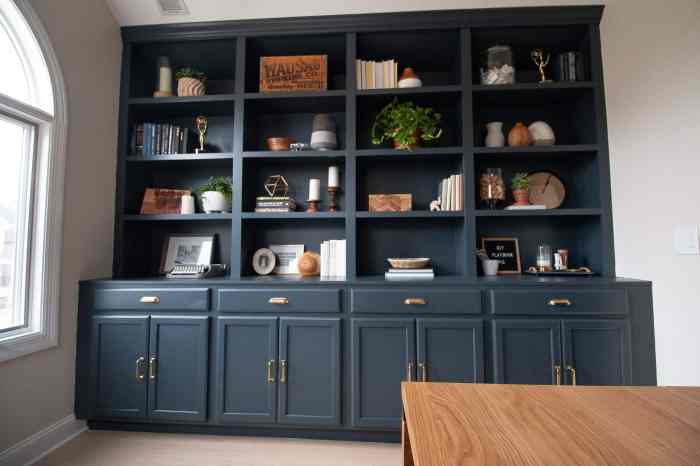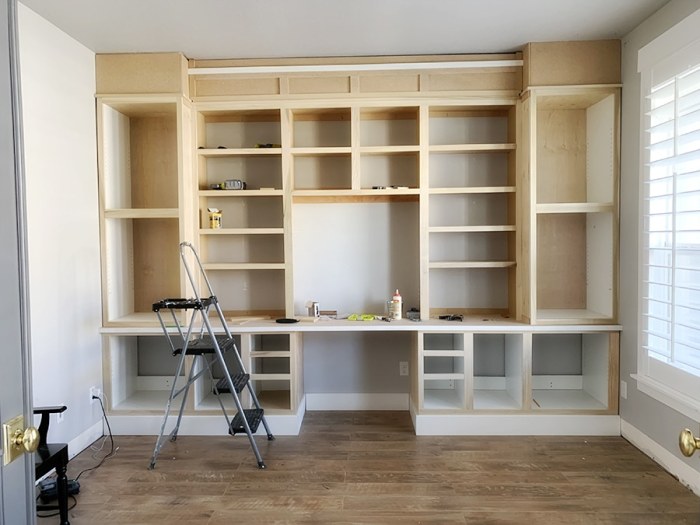Diy office built ins – DIY office built-ins offer a fantastic way to transform your workspace into a personalized haven of efficiency and style. Whether you crave a minimalist sanctuary or a traditional, organized haven, building your own office built-ins allows you to tailor every detail to your specific needs and aesthetic preferences.
From planning and designing to construction and optimization, this guide will walk you through the entire process, providing practical tips, insightful advice, and inspiring ideas to bring your dream office to life.
Designing Your Office Built-Ins

Designing and building office built-ins can transform your workspace into a highly functional and stylish environment. Whether you’re seeking to maximize storage, create a dedicated work area, or simply enhance the aesthetics of your office, built-ins offer a tailored solution. This section will guide you through the design process, helping you create office built-ins that meet your specific needs and preferences.
Choosing a Design Style
The design style of your office built-ins should complement the overall aesthetic of your workspace. Here are some popular styles to consider:
- Minimalist: Minimalist built-ins prioritize clean lines, simple forms, and a streamlined appearance. They often feature open shelving, hidden storage compartments, and a neutral color palette. Minimalist built-ins create a sense of spaciousness and order, ideal for modern or contemporary offices.
- Traditional: Traditional built-ins embrace classic design elements, such as ornate moldings, decorative accents, and warm wood tones. They often incorporate closed cabinets, drawers, and intricate details, adding a touch of elegance and sophistication to the office space.
- Modern: Modern built-ins emphasize functionality and contemporary design. They typically feature sleek lines, geometric shapes, and a focus on materials like metal, glass, and high-quality laminates. Modern built-ins create a clean and sophisticated look, perfect for contemporary or minimalist offices.
Key Features to Incorporate
When designing your office built-ins, consider the following key features to maximize functionality and style:
- Storage Solutions: Built-ins provide ample storage opportunities. Plan for a variety of storage solutions, including closed cabinets, open shelves, drawers, and file organizers. Consider the types of items you need to store and allocate space accordingly.
- Work Surfaces: A well-designed work surface is essential for a functional office. Consider the size and shape of your desk, ensuring sufficient space for your computer, paperwork, and other essentials. You can incorporate a built-in desk, a separate work surface, or a combination of both.
- Lighting: Proper lighting is crucial for a productive workspace. Integrate lighting into your built-ins, such as overhead lights, under-cabinet lighting, or task lighting. Ensure sufficient illumination for reading, writing, and working on a computer.
Creating a Detailed Plan
Once you’ve chosen a design style and identified key features, it’s time to create a detailed plan for your built-ins. This plan should include:
- Measurements: Accurately measure the space where the built-ins will be installed. This includes the height, width, and depth of the area, as well as any existing features like windows or doors.
- Sketches: Create detailed sketches of the built-ins, showing the layout, dimensions, and placement of storage solutions, work surfaces, and other features. You can use graph paper, CAD software, or even hand-drawn sketches.
- Material Selection: Choose materials that are durable, aesthetically pleasing, and suitable for your office environment. Consider factors like wood species, laminates, paint colors, and hardware finishes.
- Budget: Determine a realistic budget for the project, including materials, labor, and any necessary permits. Research prices for different materials and contractors to ensure your budget is aligned with your design goals.
Troubleshooting and Maintenance

While building your office built-ins is a rewarding DIY project, some challenges might arise during construction. Additionally, proper maintenance is essential to ensure the longevity and functionality of your built-ins. This section addresses potential problems and provides solutions, along with tips for maintaining and troubleshooting common issues.
Potential Challenges and Solutions
During construction, various challenges can arise. Here are some common issues and their solutions:
- Uneven Walls: Uneven walls can cause misaligned cabinets and shelves. To address this, use shims or leveling wedges to ensure that the cabinets are plumb and level. You can also use a laser level to check for accuracy.
- Cutting Errors: Incorrect cuts can lead to gaps or misaligned pieces. Double-check your measurements before cutting and use a quality saw for precise cuts.
- Material Defects: Wood can have knots or imperfections that might affect its strength or appearance. Inspect your materials carefully before starting construction and consider using quality plywood or engineered wood for stability.
- Installation Issues: Installing cabinets and shelves correctly is crucial. Use appropriate fasteners and ensure that they are securely attached to the wall studs.
Maintaining Your Office Built-Ins
Proper maintenance is crucial for the longevity and functionality of your office built-ins. Here are some tips for keeping them in top condition:
- Regular Cleaning: Dust and debris can accumulate on surfaces and hardware. Regular cleaning with a soft cloth and mild cleaner will help prevent dirt buildup and maintain their appearance.
- Lubricating Drawers and Hinges: Drawers and hinges can become stiff over time. Apply a light lubricant, such as furniture polish or silicone spray, to keep them moving smoothly.
- Inspecting for Damage: Regularly check for any signs of damage, such as scratches, dents, or loose screws. Address these issues promptly to prevent further damage.
- Adjusting Shelves and Drawers: As your office built-ins settle, you might need to adjust shelves or drawers to ensure proper alignment and functionality.
Troubleshooting Common Problems, Diy office built ins
Here are some common problems you might encounter and how to address them:
Squeaky Drawers
Squeaky drawers are a common problem. To address this:
- Lubricate the Runners: Apply a light lubricant, such as furniture polish or silicone spray, to the drawer runners.
- Tighten Loose Screws: Check for any loose screws on the drawer sides or runners and tighten them.
- Adjust Drawer Alignment: If the drawers are misaligned, you can adjust them by moving the drawer slides.
Sagging Shelves
Sagging shelves can occur if they are overloaded or not properly supported. To address this:
- Reduce Weight: Remove any heavy items from the sagging shelf.
- Add Support: Consider adding a shelf support bracket or a piece of wood underneath the shelf for additional support.
- Replace Shelf: If the shelf is damaged or too weak, you might need to replace it with a thicker or more durable material.
Safety Precautions: Diy Office Built Ins

Building your own office built-ins is a rewarding project, but it’s essential to prioritize safety throughout the process. This section will cover key safety measures, proper tool usage, and handling potentially hazardous materials.
Using Power Tools Safely
Power tools can be invaluable for building office built-ins, but they also pose risks if not used correctly. Here are some safety guidelines:
- Always wear safety glasses to protect your eyes from flying debris.
- Use hearing protection, such as earplugs or earmuffs, to prevent noise-induced hearing loss.
- Ensure the work area is well-lit and free of clutter to prevent tripping hazards.
- Keep your fingers away from the blade or cutting edge of any power tool.
- Use the appropriate tool for the task and always follow the manufacturer’s instructions.
- Disconnect power tools from the power source before making adjustments or changing blades.
- Never use a tool if it is damaged or malfunctioning.
Handling Hazardous Materials
Some materials used in built-in construction, such as wood preservatives, paints, and adhesives, can be hazardous.
- Always wear a respirator mask when working with materials that release fumes or dust.
- Use gloves to protect your hands from contact with irritants or chemicals.
- Store hazardous materials in well-ventilated areas, away from heat and direct sunlight.
- Follow the manufacturer’s instructions for safe handling and disposal of hazardous materials.
- Keep children and pets away from hazardous materials.
General Safety Tips
- Always wear closed-toe shoes to protect your feet from falling objects or sharp tools.
- Use a ladder or step stool that is rated for your weight and the height you need to reach.
- Avoid working alone, especially when using power tools or handling heavy objects.
- Keep a first-aid kit readily available in case of minor injuries.
- Be aware of your surroundings and be cautious of potential hazards.
By embarking on this DIY project, you’ll not only create a functional and visually appealing workspace but also gain a sense of accomplishment and satisfaction from crafting something unique and tailored to your needs. With careful planning, a touch of creativity, and the right tools, you can easily transform your office into a personalized sanctuary that reflects your individual style and enhances your productivity.
Building DIY office built-ins can be a great way to maximize space and add a touch of personality to your workspace. But, don’t forget about the importance of creating a comfortable and inviting outdoor space as well. If you’re looking for some inspiration for your patio, check out these patio chairs DIY projects. Once you’ve got your outdoor oasis sorted, you can return to your organized and efficient office, knowing that your built-in shelves are keeping everything in its place.

